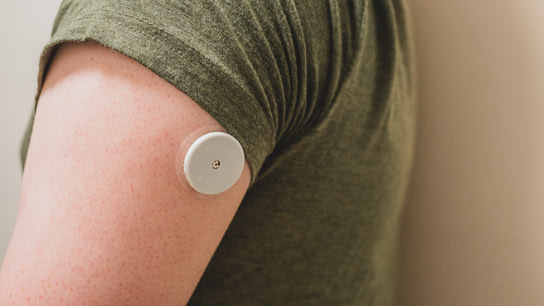The Abbott FreeStyle Libre 2 is a flash-glucose monitoring system consisting of a glucose sensor attached to the back of the upper arm and either a reader device or smartphone app. So, what’s it like to wear something glued on to your upper arm for 14 days at a time?
I’ve got some great news for any diabetic who’s worried about how it’s like to wear the FreeStyle Libre 2 sensor. For most of the day, I don’t notice it at all.
The only times in a day that I think about the sensor is when I shower, pull off T-shirts, lay restless in bed, collide with door frames, and when I’m dehydrated. I’ll go through each of these points in turn.
Showering was the thing I was the most worried about the first few weeks wearing the sensor. It’s supposed to stay on for 14 days, but I was worried that getting it wet would loosen the adhesive. It can get wet, but warm water may loosen it. In my experience, the adhesive begins loosening at the edges after a couple of showers. The sensor hasn’t yet come off from showering, however.
Showering with different medical-adhesive-patches is a long-since solved problem and you shouldn’t worry about it as I did. I’ve started covering the sensor with some waterproof adhesive film when I shower. You can get specially designed adhesive patches for the FreeStyle Libre Sensor. However, these are a waste of money for something that you’ll only wear for a couple of minutes.
There’s undeniably a plastic lump stuck to my arm. You usually can’t see it from under clothing — dependent on the exact sensor placement and sleeve length — unless you know it’s there. It’s only visible on the cover photo for this article because the photo is staged.
However, I do notice that the sensor is there when I’m pulling off shirts. They can sometimes snag on it and yank a bit in the sensor. I was a bit worried about it the first couple of times, but again this is something that I was worried about for no good reason.
I haven’t had any problems sleeping with the FreeStyle Libre Sensor. I barely notice the sensor when I put my body weight as I turn over in bed on the side where the sensor sits. As with clothing, the biggest hurdle is when it snags on the bed linens. I was worried either my significant other or I would yank it off while we slept. So far, I’ve only scratched at it in my sleep and it hasn’t come off.
I’ve already learned to respect door handles and knobs as an insulin-pump user. The pump sits in my jeans pocket with the insulin delivery tubing going over my clothing and up to the injection site on my abdomen. The loose tubing often form a loop that gets stuck on door handles which can yank it out.
I’ve now also got a newfound respect for door frames since I started wearing the FreeStyle Libre 2 Sensor. I never gave any thought to how frequently my upper arm impact with a door frame throughout the week. It turns out that I bump into door frames all the time.
For example, when I try to quickly pass through a door or when I need to push past people to get off a bus or tram. I haven’t torn off the FreeStyle Libre sensor by colliding against a door frame yet. However, I’m sure it’s only a matter of time before it happens.
It’s not that diabetic-treatment devices aren’t designed to be door-friendly. The problem is that many doors aren’t all that human-friendly. Doors that automatically close on you are mostly a minor annoyance, but your heart skips a beat when there’s a risk of tearing the sensor off your arm.
The only times I’ve felt any pain from wearing the FreeStyle Libre Sensor have been when I’ve felt dehydrated. For example, on warm days or after exercise when I haven’t been drinking enough water. I’ve felt little jolts of pain, like a pinched nerve or being pricked by a needle, emanating from the sensor injection site. These symptoms go away half an hour after I’ve seen to my body’s hydration needs.
This may all sound terribly inconvenient and like a pain in the back. However, we diabetics don’t have any choice but to keep an eye on our glucose levels throughout the day. While not a fully-featured continuous glucose monitor (CGM) system, the FreeStyle Libre 2 is still a huge improvement over performing dozens of finger-prick blood-tests every day.
(Please note that there are regional differences regarding how long the sensor can be worn before it should be replaced. This is due to different regulations and requirements around the world.)
